Finance Report: Capital Budgeting Project Analysis and Recommendations
VerifiedAdded on 2021/06/14
|7
|1180
|308
Report
AI Summary
This finance memorandum analyzes a new project using capital budgeting techniques. The analysis includes the estimation of incremental cash flows, calculation of Net Present Value (NPV), Internal Rate of Return (IRR), payback period, discounted payback period, and profitability index. The report also incorporates uncertainty analysis through sensitivity and scenario analysis to assess the project's viability under different conditions. The student recommends undertaking the project based on positive NPV, IRR exceeding the cost of capital, and favorable payback periods. The analysis considers sunk costs, opportunity costs, depreciation, and working capital investments. The report concludes with a recommendation to undertake the project, supported by the results of the capital budgeting techniques and the sensitivity analysis. The report uses several finance references to support the analysis.
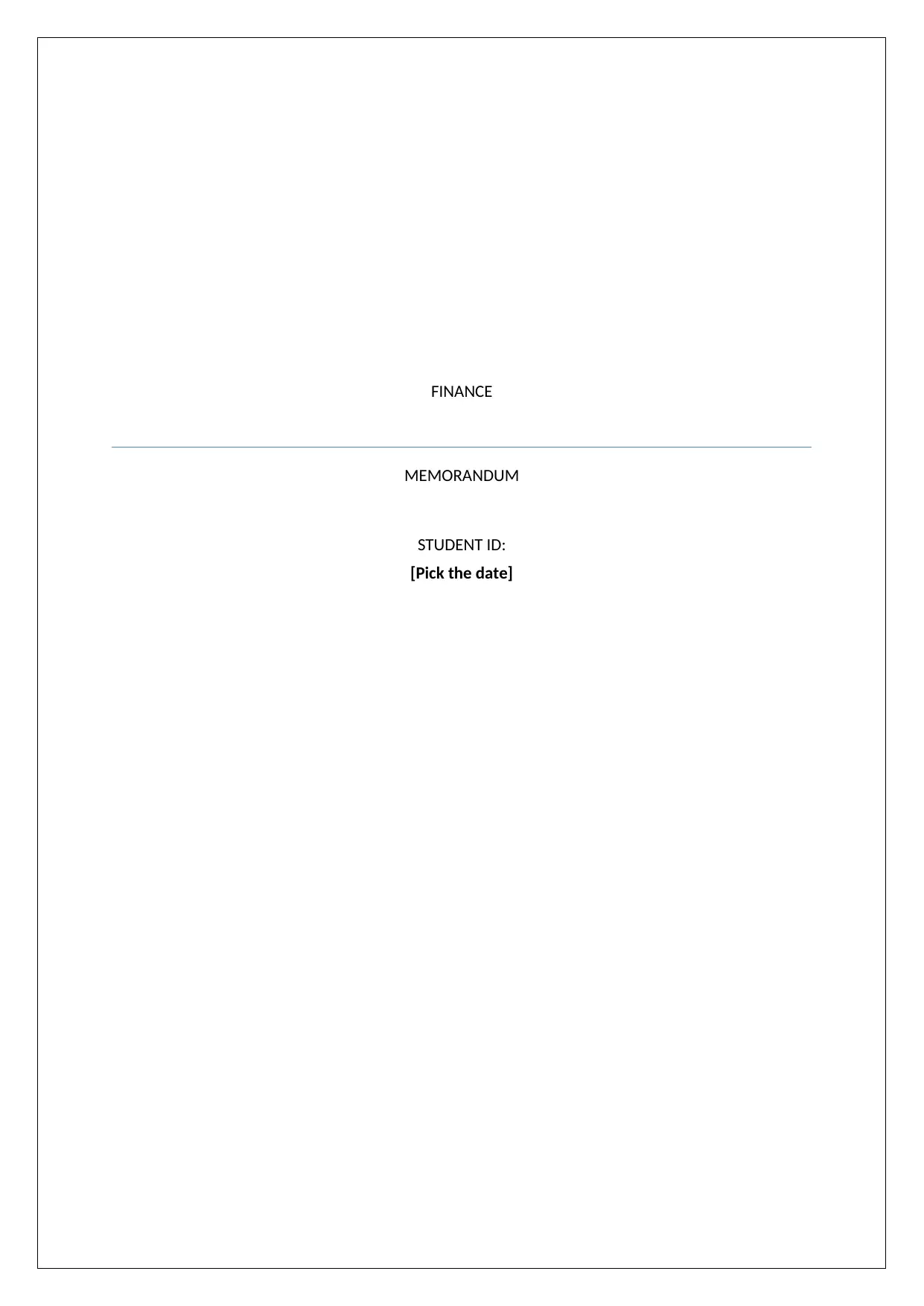
FINANCE
MEMORANDUM
STUDENT ID:
[Pick the date]
MEMORANDUM
STUDENT ID:
[Pick the date]
Paraphrase This Document
Need a fresh take? Get an instant paraphrase of this document with our AI Paraphraser
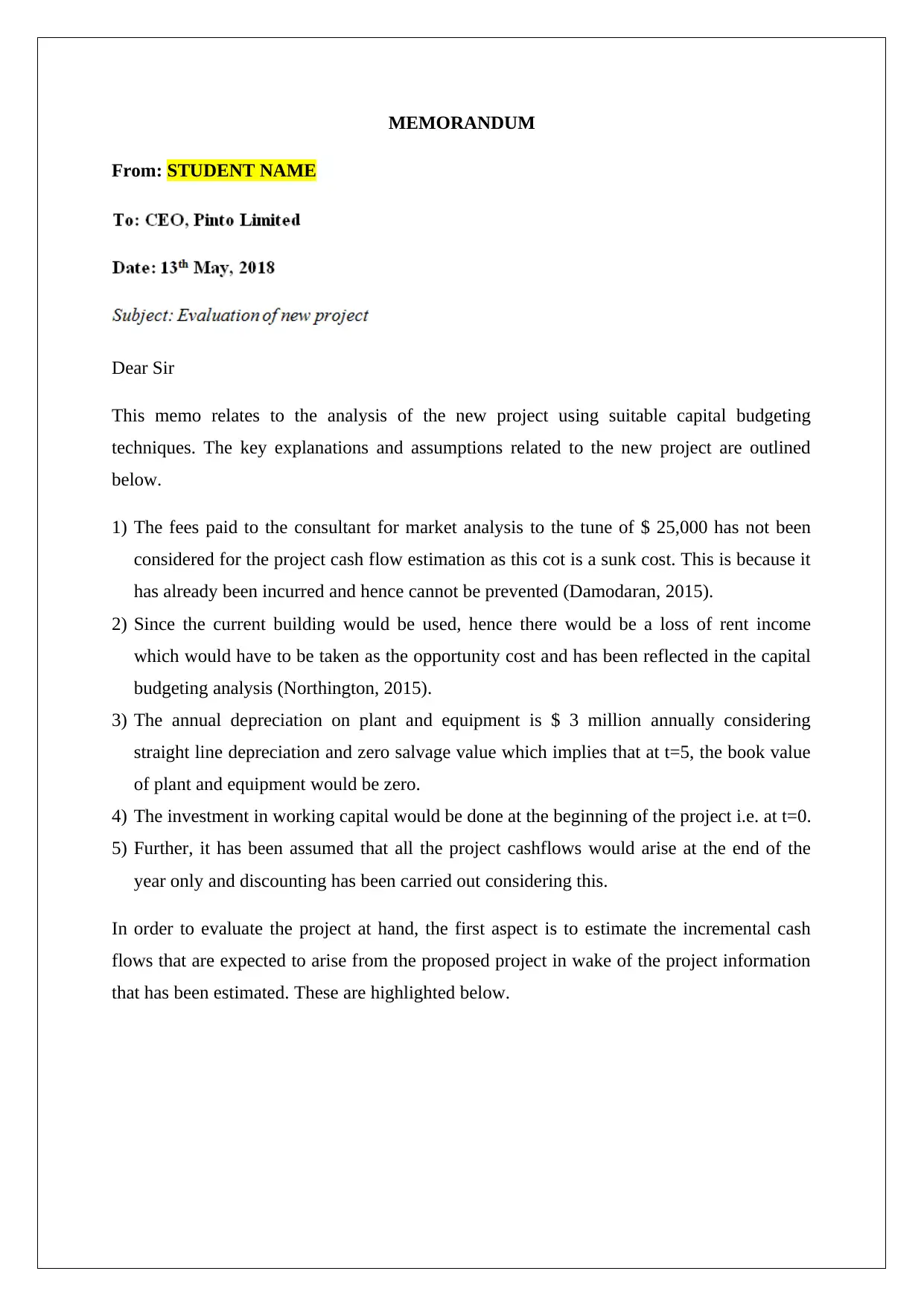
MEMORANDUM
From: STUDENT NAME
Dear Sir
This memo relates to the analysis of the new project using suitable capital budgeting
techniques. The key explanations and assumptions related to the new project are outlined
below.
1) The fees paid to the consultant for market analysis to the tune of $ 25,000 has not been
considered for the project cash flow estimation as this cot is a sunk cost. This is because it
has already been incurred and hence cannot be prevented (Damodaran, 2015).
2) Since the current building would be used, hence there would be a loss of rent income
which would have to be taken as the opportunity cost and has been reflected in the capital
budgeting analysis (Northington, 2015).
3) The annual depreciation on plant and equipment is $ 3 million annually considering
straight line depreciation and zero salvage value which implies that at t=5, the book value
of plant and equipment would be zero.
4) The investment in working capital would be done at the beginning of the project i.e. at t=0.
5) Further, it has been assumed that all the project cashflows would arise at the end of the
year only and discounting has been carried out considering this.
In order to evaluate the project at hand, the first aspect is to estimate the incremental cash
flows that are expected to arise from the proposed project in wake of the project information
that has been estimated. These are highlighted below.
From: STUDENT NAME
Dear Sir
This memo relates to the analysis of the new project using suitable capital budgeting
techniques. The key explanations and assumptions related to the new project are outlined
below.
1) The fees paid to the consultant for market analysis to the tune of $ 25,000 has not been
considered for the project cash flow estimation as this cot is a sunk cost. This is because it
has already been incurred and hence cannot be prevented (Damodaran, 2015).
2) Since the current building would be used, hence there would be a loss of rent income
which would have to be taken as the opportunity cost and has been reflected in the capital
budgeting analysis (Northington, 2015).
3) The annual depreciation on plant and equipment is $ 3 million annually considering
straight line depreciation and zero salvage value which implies that at t=5, the book value
of plant and equipment would be zero.
4) The investment in working capital would be done at the beginning of the project i.e. at t=0.
5) Further, it has been assumed that all the project cashflows would arise at the end of the
year only and discounting has been carried out considering this.
In order to evaluate the project at hand, the first aspect is to estimate the incremental cash
flows that are expected to arise from the proposed project in wake of the project information
that has been estimated. These are highlighted below.
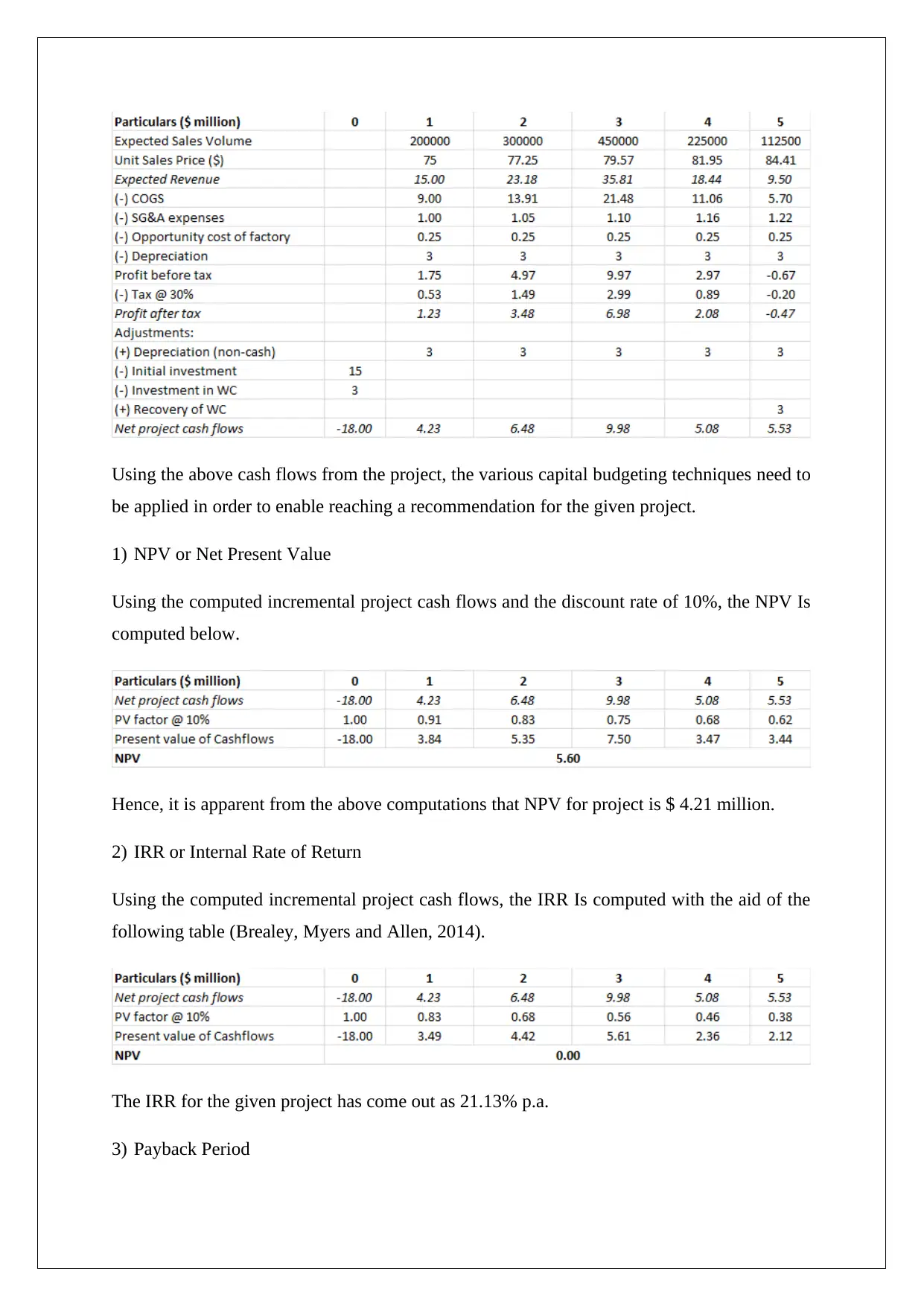
Using the above cash flows from the project, the various capital budgeting techniques need to
be applied in order to enable reaching a recommendation for the given project.
1) NPV or Net Present Value
Using the computed incremental project cash flows and the discount rate of 10%, the NPV Is
computed below.
Hence, it is apparent from the above computations that NPV for project is $ 4.21 million.
2) IRR or Internal Rate of Return
Using the computed incremental project cash flows, the IRR Is computed with the aid of the
following table (Brealey, Myers and Allen, 2014).
The IRR for the given project has come out as 21.13% p.a.
3) Payback Period
be applied in order to enable reaching a recommendation for the given project.
1) NPV or Net Present Value
Using the computed incremental project cash flows and the discount rate of 10%, the NPV Is
computed below.
Hence, it is apparent from the above computations that NPV for project is $ 4.21 million.
2) IRR or Internal Rate of Return
Using the computed incremental project cash flows, the IRR Is computed with the aid of the
following table (Brealey, Myers and Allen, 2014).
The IRR for the given project has come out as 21.13% p.a.
3) Payback Period
⊘ This is a preview!⊘
Do you want full access?
Subscribe today to unlock all pages.

Trusted by 1+ million students worldwide
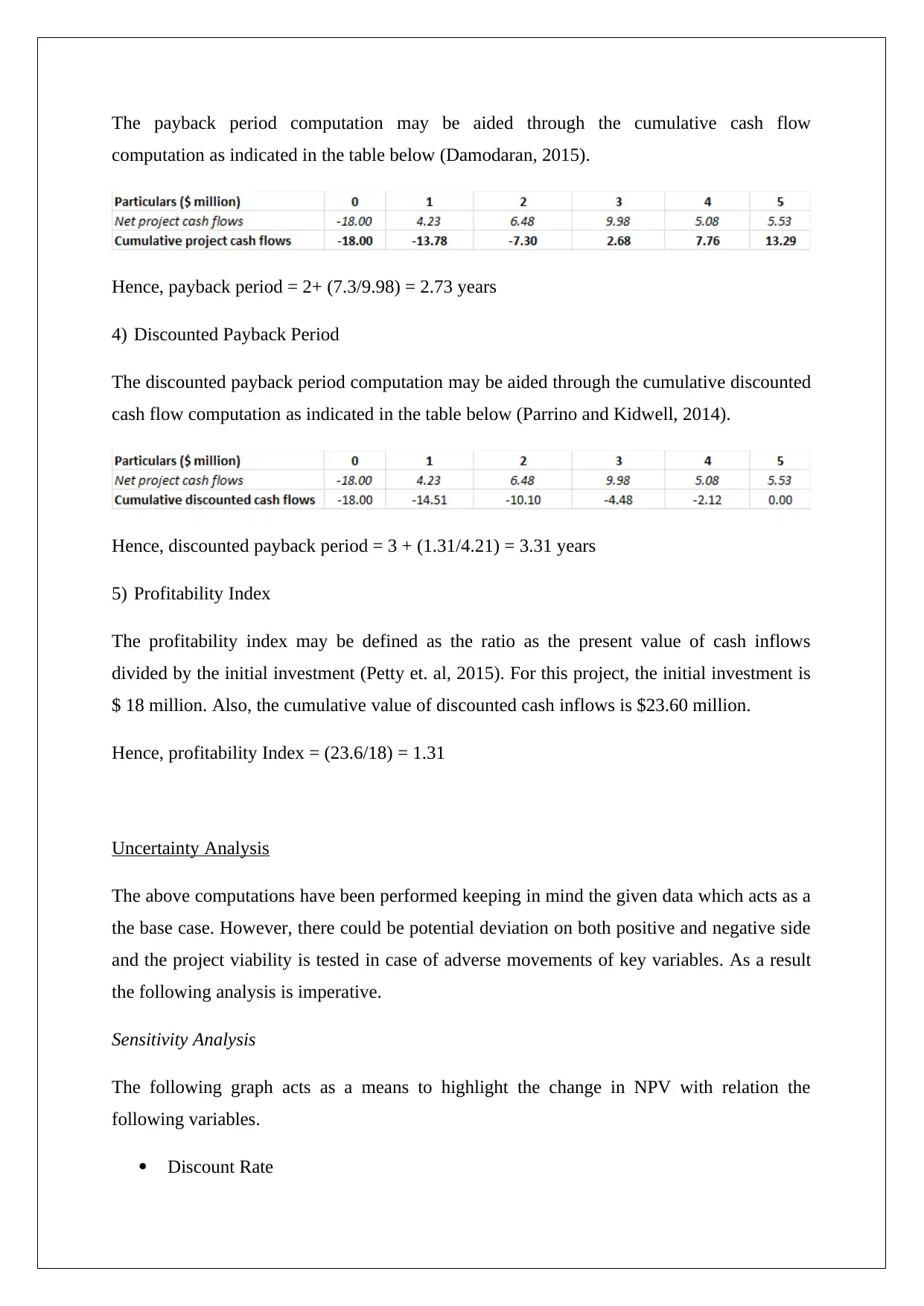
The payback period computation may be aided through the cumulative cash flow
computation as indicated in the table below (Damodaran, 2015).
Hence, payback period = 2+ (7.3/9.98) = 2.73 years
4) Discounted Payback Period
The discounted payback period computation may be aided through the cumulative discounted
cash flow computation as indicated in the table below (Parrino and Kidwell, 2014).
Hence, discounted payback period = 3 + (1.31/4.21) = 3.31 years
5) Profitability Index
The profitability index may be defined as the ratio as the present value of cash inflows
divided by the initial investment (Petty et. al, 2015). For this project, the initial investment is
$ 18 million. Also, the cumulative value of discounted cash inflows is $23.60 million.
Hence, profitability Index = (23.6/18) = 1.31
Uncertainty Analysis
The above computations have been performed keeping in mind the given data which acts as a
the base case. However, there could be potential deviation on both positive and negative side
and the project viability is tested in case of adverse movements of key variables. As a result
the following analysis is imperative.
Sensitivity Analysis
The following graph acts as a means to highlight the change in NPV with relation the
following variables.
Discount Rate
computation as indicated in the table below (Damodaran, 2015).
Hence, payback period = 2+ (7.3/9.98) = 2.73 years
4) Discounted Payback Period
The discounted payback period computation may be aided through the cumulative discounted
cash flow computation as indicated in the table below (Parrino and Kidwell, 2014).
Hence, discounted payback period = 3 + (1.31/4.21) = 3.31 years
5) Profitability Index
The profitability index may be defined as the ratio as the present value of cash inflows
divided by the initial investment (Petty et. al, 2015). For this project, the initial investment is
$ 18 million. Also, the cumulative value of discounted cash inflows is $23.60 million.
Hence, profitability Index = (23.6/18) = 1.31
Uncertainty Analysis
The above computations have been performed keeping in mind the given data which acts as a
the base case. However, there could be potential deviation on both positive and negative side
and the project viability is tested in case of adverse movements of key variables. As a result
the following analysis is imperative.
Sensitivity Analysis
The following graph acts as a means to highlight the change in NPV with relation the
following variables.
Discount Rate
Paraphrase This Document
Need a fresh take? Get an instant paraphrase of this document with our AI Paraphraser
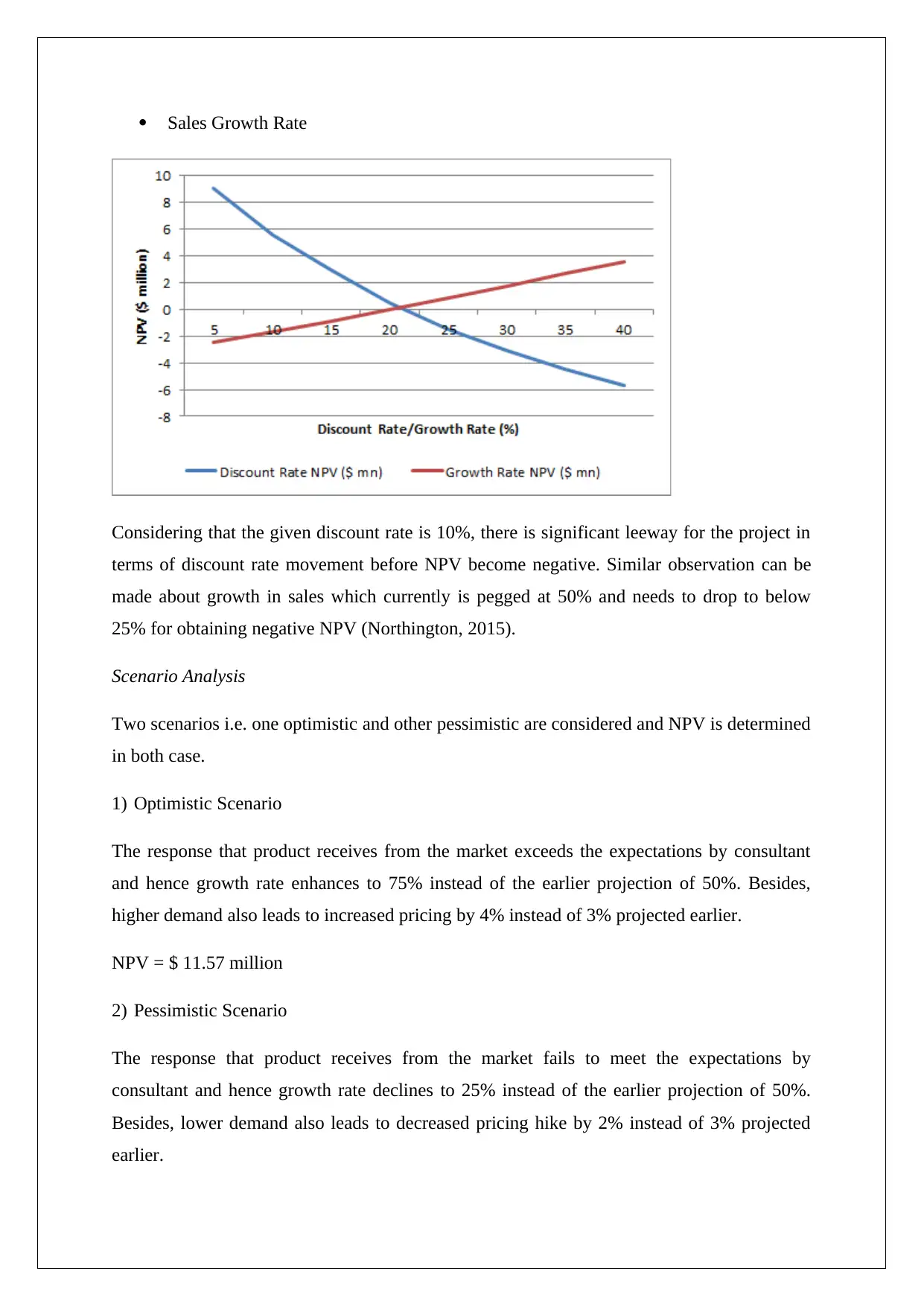
Sales Growth Rate
Considering that the given discount rate is 10%, there is significant leeway for the project in
terms of discount rate movement before NPV become negative. Similar observation can be
made about growth in sales which currently is pegged at 50% and needs to drop to below
25% for obtaining negative NPV (Northington, 2015).
Scenario Analysis
Two scenarios i.e. one optimistic and other pessimistic are considered and NPV is determined
in both case.
1) Optimistic Scenario
The response that product receives from the market exceeds the expectations by consultant
and hence growth rate enhances to 75% instead of the earlier projection of 50%. Besides,
higher demand also leads to increased pricing by 4% instead of 3% projected earlier.
NPV = $ 11.57 million
2) Pessimistic Scenario
The response that product receives from the market fails to meet the expectations by
consultant and hence growth rate declines to 25% instead of the earlier projection of 50%.
Besides, lower demand also leads to decreased pricing hike by 2% instead of 3% projected
earlier.
Considering that the given discount rate is 10%, there is significant leeway for the project in
terms of discount rate movement before NPV become negative. Similar observation can be
made about growth in sales which currently is pegged at 50% and needs to drop to below
25% for obtaining negative NPV (Northington, 2015).
Scenario Analysis
Two scenarios i.e. one optimistic and other pessimistic are considered and NPV is determined
in both case.
1) Optimistic Scenario
The response that product receives from the market exceeds the expectations by consultant
and hence growth rate enhances to 75% instead of the earlier projection of 50%. Besides,
higher demand also leads to increased pricing by 4% instead of 3% projected earlier.
NPV = $ 11.57 million
2) Pessimistic Scenario
The response that product receives from the market fails to meet the expectations by
consultant and hence growth rate declines to 25% instead of the earlier projection of 50%.
Besides, lower demand also leads to decreased pricing hike by 2% instead of 3% projected
earlier.
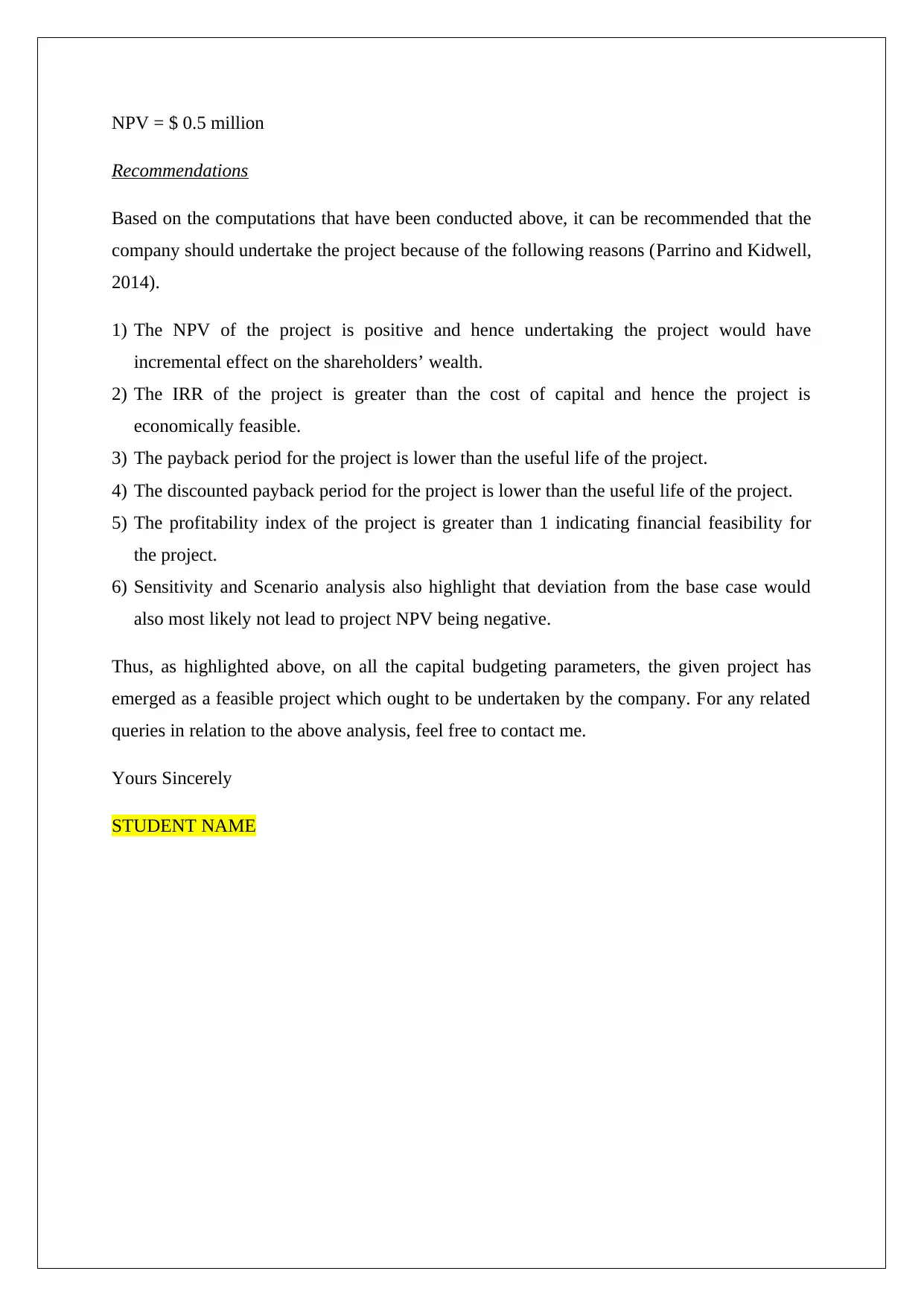
NPV = $ 0.5 million
Recommendations
Based on the computations that have been conducted above, it can be recommended that the
company should undertake the project because of the following reasons (Parrino and Kidwell,
2014).
1) The NPV of the project is positive and hence undertaking the project would have
incremental effect on the shareholders’ wealth.
2) The IRR of the project is greater than the cost of capital and hence the project is
economically feasible.
3) The payback period for the project is lower than the useful life of the project.
4) The discounted payback period for the project is lower than the useful life of the project.
5) The profitability index of the project is greater than 1 indicating financial feasibility for
the project.
6) Sensitivity and Scenario analysis also highlight that deviation from the base case would
also most likely not lead to project NPV being negative.
Thus, as highlighted above, on all the capital budgeting parameters, the given project has
emerged as a feasible project which ought to be undertaken by the company. For any related
queries in relation to the above analysis, feel free to contact me.
Yours Sincerely
STUDENT NAME
Recommendations
Based on the computations that have been conducted above, it can be recommended that the
company should undertake the project because of the following reasons (Parrino and Kidwell,
2014).
1) The NPV of the project is positive and hence undertaking the project would have
incremental effect on the shareholders’ wealth.
2) The IRR of the project is greater than the cost of capital and hence the project is
economically feasible.
3) The payback period for the project is lower than the useful life of the project.
4) The discounted payback period for the project is lower than the useful life of the project.
5) The profitability index of the project is greater than 1 indicating financial feasibility for
the project.
6) Sensitivity and Scenario analysis also highlight that deviation from the base case would
also most likely not lead to project NPV being negative.
Thus, as highlighted above, on all the capital budgeting parameters, the given project has
emerged as a feasible project which ought to be undertaken by the company. For any related
queries in relation to the above analysis, feel free to contact me.
Yours Sincerely
STUDENT NAME
⊘ This is a preview!⊘
Do you want full access?
Subscribe today to unlock all pages.

Trusted by 1+ million students worldwide
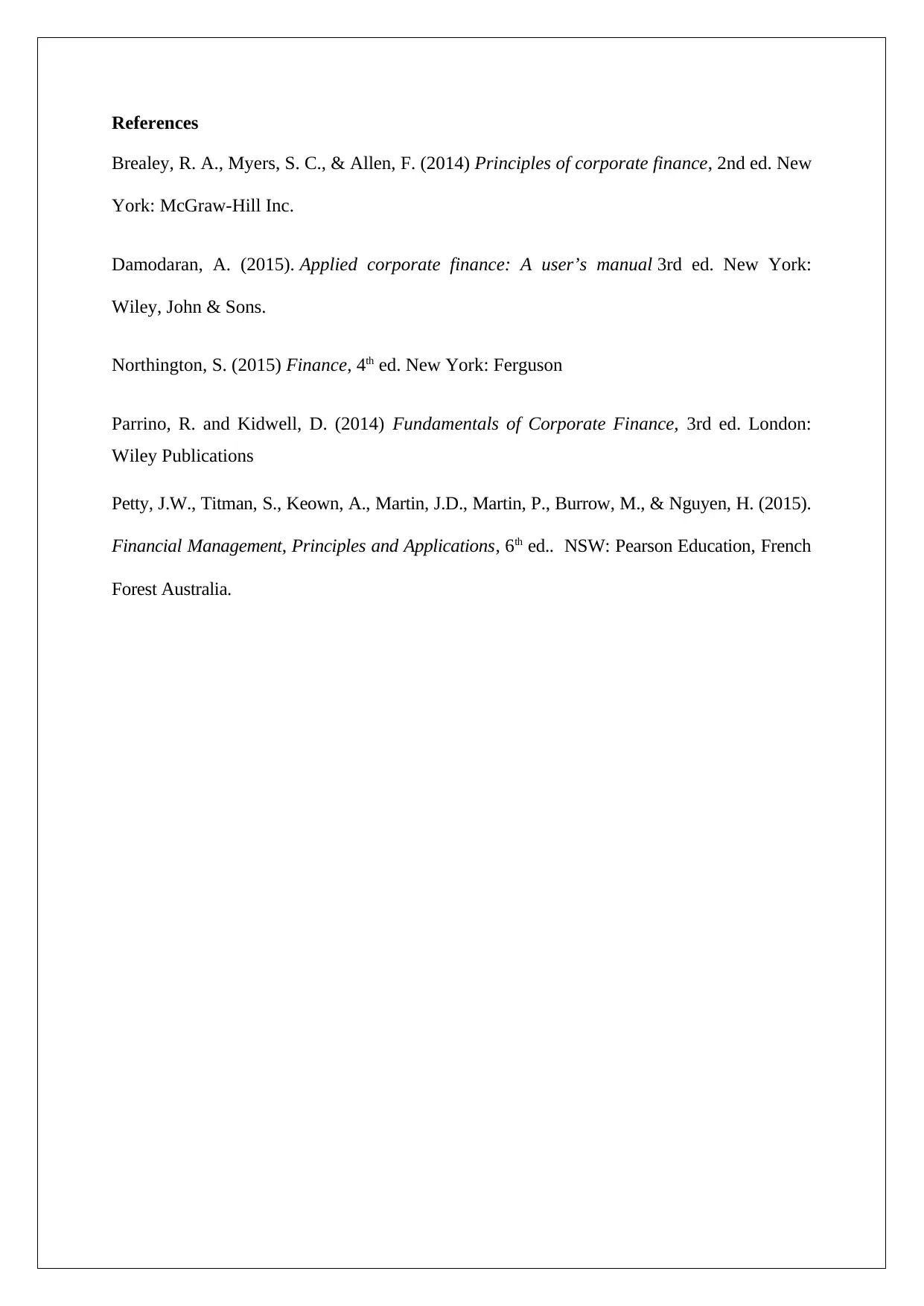
References
Brealey, R. A., Myers, S. C., & Allen, F. (2014) Principles of corporate finance, 2nd ed. New
York: McGraw-Hill Inc.
Damodaran, A. (2015). Applied corporate finance: A user’s manual 3rd ed. New York:
Wiley, John & Sons.
Northington, S. (2015) Finance, 4th ed. New York: Ferguson
Parrino, R. and Kidwell, D. (2014) Fundamentals of Corporate Finance, 3rd ed. London:
Wiley Publications
Petty, J.W., Titman, S., Keown, A., Martin, J.D., Martin, P., Burrow, M., & Nguyen, H. (2015).
Financial Management, Principles and Applications, 6th ed.. NSW: Pearson Education, French
Forest Australia.
Brealey, R. A., Myers, S. C., & Allen, F. (2014) Principles of corporate finance, 2nd ed. New
York: McGraw-Hill Inc.
Damodaran, A. (2015). Applied corporate finance: A user’s manual 3rd ed. New York:
Wiley, John & Sons.
Northington, S. (2015) Finance, 4th ed. New York: Ferguson
Parrino, R. and Kidwell, D. (2014) Fundamentals of Corporate Finance, 3rd ed. London:
Wiley Publications
Petty, J.W., Titman, S., Keown, A., Martin, J.D., Martin, P., Burrow, M., & Nguyen, H. (2015).
Financial Management, Principles and Applications, 6th ed.. NSW: Pearson Education, French
Forest Australia.
1 out of 7
Related Documents
Your All-in-One AI-Powered Toolkit for Academic Success.
+13062052269
info@desklib.com
Available 24*7 on WhatsApp / Email
![[object Object]](/_next/static/media/star-bottom.7253800d.svg)
Unlock your academic potential
Copyright © 2020–2025 A2Z Services. All Rights Reserved. Developed and managed by ZUCOL.




